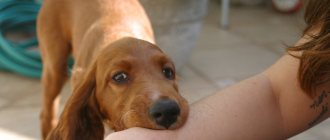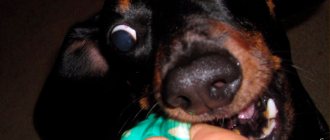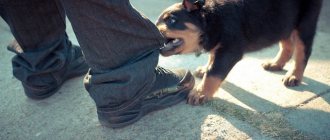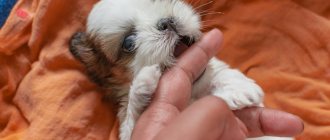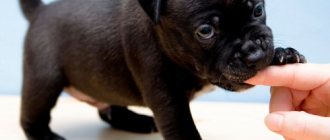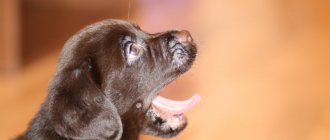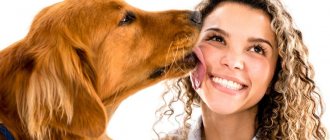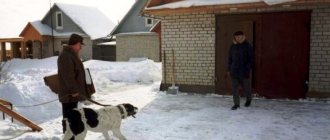All puppies bite. This is normal behavior. But it needs to be corrected from the first months of life. By six months, instead of light scratches, serious wounds from the teeth will remain on the owner’s body. And it will become difficult to stop your dog from grabbing arms and legs.
In the article we will tell you how to wean puppies of different ages from biting their legs and arms, we will describe the reasons and all methods of correction - from gentle home ones to complex ones, which are carried out in pairs with a dog handler. We will also point out the main mistakes of novice owners and explain how to avoid them.
Why do puppies bite?
Any kitten bites. This behavior is dictated by instincts. Until 3-4 months, he still does not know how to contact the outside world, people and animals in a different way. The owner’s task is to determine exactly why the puppy is doing this and explain to him how to properly interact with the environment.
Small puppies constantly grab their owners' legs and arms for the following reasons:
- Environmental research.
A puppy is the same child. Small children touch everything with their hands and put it in their mouth. So is the kitten. But he has no hands - he uses his teeth. Therefore, the dog chews everything up to 2-3 months: from things to human feet. - Communication.
Until 1–2 months, the puppy communicated with its mother, sisters and brothers through bites. And, once at your home, he continues to contact new family members in the same way. He still doesn’t know how to “talk” any other way. - Fun.
During the game, the dogs jump up and bite each other. The puppy transfers the same behavior to people. - Test of strength.
By grabbing people with its teeth, the pet tests its strength and limits of what is permitted. Plus he learns to attack, bite and fight correctly. - Honing the hunting instinct.
If a puppy attacks people walking by and bites their legs, this is a manifestation of innate pursuit skills. This occurs most often in hunting breeds, but can occur in any dog. - Changing teeth.
From the age of 3–4 months, kittens' teeth change. The process is uncomfortable, so babies chew on everything to relieve pain and itching. The “distribution” includes toys, clothes, floors, furniture and family members.
The reasons listed are normal. If your puppy bites due to these factors, you need to teach him how to properly communicate with people and animals.
But sometimes bites are caused by behavioral problems:
- aggression (food, territorial, possessive, defensive);
- past stress: abuse or severe fear;
- illness;
- lack or lack of socialization;
- dominance: the pet is trying to become the leader of the family or has already taken the position of leader.
The first, normal causes are eliminated on their own. The second, related to psychological problems, is corrected together with a dog handler.
Are play bites by an adult dog aggression?
Basically, the use of teeth is a normal, species-typical behavior of a dog, because teeth are one of the ways to explore this world. It is important that play bites do not injure a person or cause pain. Play bites, even strong ones, are not a manifestation of aggression. But some dogs bite out of fear. And it is not always easy to distinguish between play bites and bites that portend manifestations of aggressive behavior.
In most cases, play bites are accompanied by dog body language indicating relaxation. She may wrinkle her nose, but her facial muscles will not look tense. Play bites are usually not as painful as aggressive bites. A dog that is showing aggression appears tense and attacks sharply and quickly.
If you suspect that your dog is showing aggression, the best thing you can do is consult with a competent professional.
Photo: google
Normal biting or behavioral defect?
Before you stop your puppy from biting, learn to differentiate between real bites and friendly nibbles. The latter are referred to as behavioral norms.
This is how the pet invites you to play, follow him, draws your attention to something interesting, or expresses love. And herding dogs can bite their legs, as if herding people or animals.
The difference between biting and normal biting is the strength of the grip. In the first case, you will be in pain and there will be a scratch or wound on your skin. In the second option, the dog will drool on his leg or arm at most.
Also make sure that the biting is not caused by the following:
- ill-treatment;
- rough games of children;
- boredom: insufficient attention, weak physical activity, lack of toys.
Biting is often provoked by incorrect actions of the owner. For example, the owner teaches the kitten to play with his hands. It is also wrong to let your pet chew on old things. They smell like you. And if you can fray and tear them, then why can’t you do the same with your legs?
Methods for weaning
In most cases, puppies stop biting when their teeth emerge (at about 8 months). Until this time, the baby should have a sufficient number of toys; he will chew them and scratch his gums, otherwise the owner’s shoes and furniture will be damaged.
As a rule, pets grab their owners' arms and legs. To get rid of this habit, you can use popular methods:
- buy enough toys and replace them with new ones on time;
- ignore negative behavior;
- treat furniture with special aerosols.
It is more difficult to wean an adult dog; you need to do this at an early age.
If the baby bites, it is recommended to put the toy in the mouth (to divert attention to another object).
When the puppy, while playing, begins to bite painfully, growl and scratch, you should stop the fun: say “ouch” and freeze for a few seconds. Cross your arms across your chest and turn your head to the side. The game continues when the baby realizes that he did something bad. Re-education should occur gradually: first of all, they stop playing for strong bites, then for medium ones.
It will not be possible to completely get rid of this phenomenon. The dog's touch should be comfortable and not cause pain. The game is a reward for good behavior.
When the puppy cannot calm down, you need to get up and leave. If he runs after his owner and continues to bite, he is locked in the next room or put on a leash until he calms down.
Avoid games where the dog might grab small children.
You cannot use physical methods of punishment, you can lightly spank him with a newspaper. It is better to teach warning commands (the command “No!”, “Ugh!”). Dogs are smart animals, they understand where they made a mistake and will try not to do it in the future so as not to upset the owner.
Children often bite because they are afraid. In this case, you need to sit down next to him, pet him, calm him down, and talk to him. In the same way, the pet attracts attention to itself. Play with him, try to spend more time, include active games while walking.
You can stop biting other dogs with the help of praise: if your pet calmly walked past a dog or cat, praise him and give him a treat.
If he lunges at other animals and people, he should only be walked on a leash.
It's quite easy to stop jumping and biting. A small puppy is simply ignored: when he starts jumping, you need to turn away. When the baby calms down, sit down and pet him (express approval of his action).
To wean a dog from biting a cat, early socialization is needed; this is the basis of education and training. The child must be a full-fledged member of society.
Adult dogs are punished at the moment of jumping: they say “Ugh!” and lightly push him away (two or three times is enough). If your pet jumps on strangers and tries to bite people, you must say the command “Ugh!” and pull the leash in your direction. Next, the command “Sit” or “Next” is given.
It is not uncommon to see a puppy chewing its tail. There are several reasons for this behavior:
- the presence of sticky plants, parasites on the tail;
- itching;
- damage;
- stress, boredom.
To stop a dog from biting its tail, the owner must examine the pet, find out the cause and eliminate it (treat it, give it a toy).
Help from a dog handler
If you have not been able to correct the behavior on your own before the age of 6 months, contact a dog trainer. Both individual and group lessons are useful. Among them:
- ordinary classes:
the dog handler will select the right technique, correct errors in education, and correct actions; - general training course (GTC):
will help develop obedience, acquire normal dog communication skills with other animals and people, and master basic commands; - protective guard service (PSC) course:
suitable for juniors older than 8 months of service and guard breeds, during which dogs will be taught to direct aggression in the right direction, taught to wean themselves from biting without reason, and shown that teeth should only be used at the command of the owner.
How to punish
If a puppy does not obey its owner, it is properly punished. When a baby is brought into the house, he is given a place to sleep and rest. If he bites, send him to “serve his punishment” in a sleeping place.
To show your strong character, grab him by the withers and press him to the ground. Another option: grab the muzzle with your hand and don’t let go for a few seconds.
If your finger ends up in the animal’s mouth, you must carefully open the jaw, remove the finger, close your teeth and strictly say “no!”
You should not physically punish your pet: he may see this as a challenge and continue his aggression. It is especially dangerous to hit small breed dogs: it is difficult to calculate the force of the blow and you can harm the animal. You should not spray various repellent sprays in the face, this will spoil your vision and sense of smell.
What not to do during behavior adjustment
Often, owners themselves make mistakes or use prohibited training methods on the puppy. It is important to remember that the goal is how to wean a puppy from biting, and not to turn it into a downtrodden or aggressive animal.
Errors and invalid methods:
- You cannot shout at the puppy, scold unnecessarily, much less beat him.
- It is important to avoid playing with hands, feet and household items.
- It is forbidden to punish a child with “walking” and “food”. These are the basic needs on which a puppy’s life depends.
- You can't show fear or fear.
- You cannot hit the puppy with your hands, equipment, or toys.
- It is strictly forbidden to train a young dog yourself.
“My prey. Will not give it back"
Dogs are terrible owners, and they instinctively protect what they have - what the owner gave them, for example, food, a bone, toys. While defending his “property”, the dog can show aggression. This is no longer a game, so you should be careful if there are children or elderly people in the house. A dog can even bite a person passing by if it suddenly seems to her that he has extended his hand to her “wealth.”
A well-mannered dog will not rush at a person, so sometimes it is easier to explain to a child that you should not pet the dog when it is eating or gnawing on a bone. It is advisable that the puppy play only under supervision, then the toys should be removed. Do not give treats that the dog will enjoy for a long time, and then decide to protect from the encroachments of humans and other animals.
Important!
Teach your pet to the fact that a person does not take, but only gives. And never use food in a game, even trying to take away a treat as a joke.
Place an empty bowl on the floor, then add pieces to it, and later teach the dog that he will get the most tasty pieces at the end of the meal. This way, the pet will consider the person a source of food and treats, and not a threat to them.
Basenji content
Keeping a Basenji dog is quite difficult. She needs to be bathed often (and the dog is afraid of water), she sheds moderately, but she needs to be walked a lot. Moreover, it should not be an aimless walk lasting 20 minutes. Walks should be long, including exercises, overcoming obstacles and various games.
If the walk is not in a closed area, but around the city, then you cannot let the cunning and agile Basenji off the leash - he will run away in search of adventure. Representatives of this breed love to chase cats, communicate with stray dogs, and eat leftovers.
Basenjis can be kept both indoors and outdoors. If the second option is preferable, then you need to take all measures to ensure that the dog feels comfortable and cannot run away: make the highest possible fence, equip an enclosure, an insulated booth, etc.
Basenjis do not tolerate frost well, so when taking your dog for a walk in the cool season, it is advisable to put on overalls.
Great importance is attached to nutrition. Food from your own table is prohibited! The best option is to use professional elite feed. If preference is given to “natural” meat, then the basis of the diet should be raw meat.
Breed standard
Basenjis have an elegant physique and well-developed muscles. There are two varieties of the breed: forest and plain.
Plains dogs are larger in size. Height at the withers is from 40 centimeters. The coat is brown with white markings. The dog's neck and chest are decorated with a white collar.
Forest Basenjis are often called pygmy for their small, compact size. Their height is below 40 centimeters. The coat color, like the eye color, is always dark.
The Basenji also has common characteristic features inherent in both species:
- The head is small, triangular in shape with a wide base.
- The forehead is wide; when the ears are raised, folds form on it, especially noticeable in puppyhood.
- The nose is narrow, the lobe with wide nostrils, black.
- The eyes are wide-set, the iris is predominantly dark. The look is smart and insightful.
- The lips are fleshy, fitting tightly to the jaws. No jowls.
- The ears are erect, slightly protruding forward.
- The neck is strong and high.
- The chest is of medium width, the stomach is tucked.
- The back is flat and not wide.
- Limbs are straight and long. The hock joints are well developed.
- The tail is set high, curled into a tight ring.
The Basenji's coat is short, close to the body, and shiny. Representatives of the breed are dogs with hypoallergenic coat.
The Basenji has several types of colors allowed by the breed standard: black and white, brown and white, red and white, brindle. Regardless of color, the paws, chest and tip of the tail are white.
